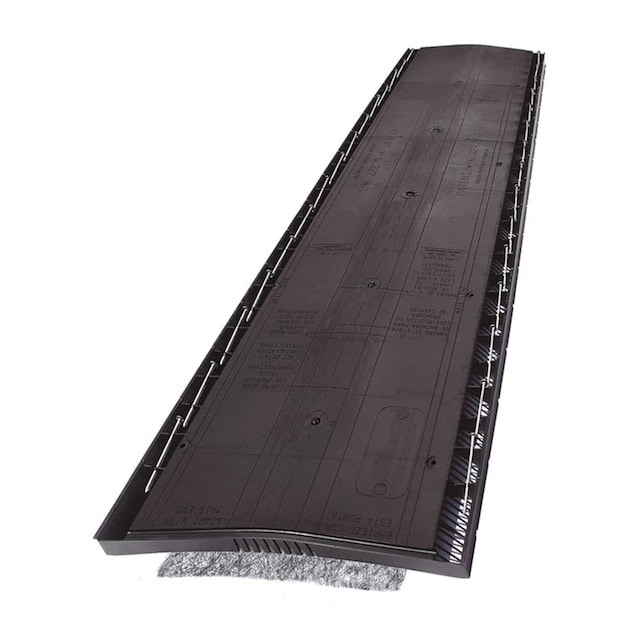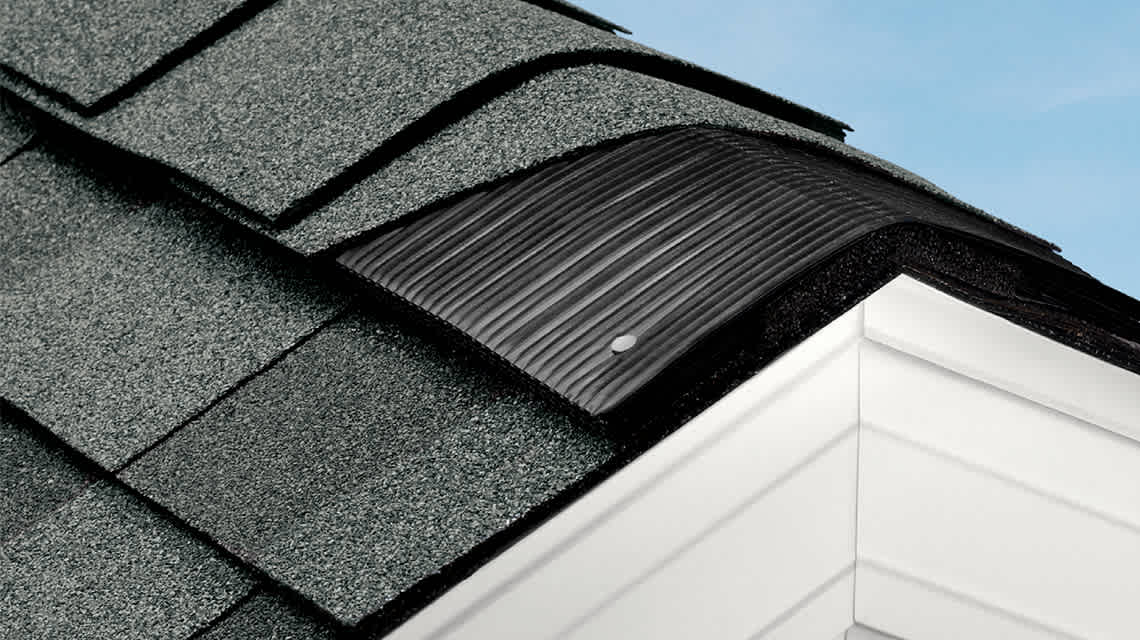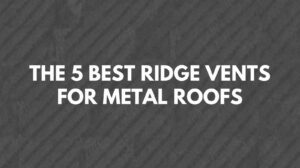Is your attic turning into a sauna during the summer, driving up energy bills after you’ve already invested in the cost of a metal roof? For homeowners with metal roofs, this is a common—and costly—problem. The solution isn’t just more insulation; it’s smarter ventilation. A high-quality ridge vent is the single most effective component for creating a cool, dry attic, a common concern for those wondering if metal roofs make your house hotter, and extending the life of your roof.
But here’s the catch: not all ridge vents are created equal, especially when it comes to the unique demands of a metal roofing system. You need a vent that can handle heavy rain, block invasive pests, withstand high winds, and provide maximum airflow without compromising the sleek look of your roof. Sifting through the options can be overwhelming. That’s where we come in.
How We Determined the Best
Our recommendations aren’t based on sponsored placements or marketing hype. We evaluated each ridge vent based on a strict set of criteria derived from years of professional experience: Net Free Area (NFA), Material Durability (resistance to UV rays, cracking, and pests), Weather Infiltration Protection (design features to block wind-driven rain and snow), and Installer-Friendliness. We’ve put these products to the test on actual job sites to ensure they live up to their claims.
Quick Summary: Top 5 Ridge Vents for Metal Roofs in 2025
| Product | Best For | Key Feature | Check Price |
|---|---|---|---|
| 1. GAF Cobra® Snow Country Advanced | Overall Performance | Superior weather/snow infiltration resistance | See on GAF Website |
| 2. Lomanco OmniRidge® Pro | Versatility & Airflow | High NFA and adaptable design | See on Amazon |
| 3. Owens Corning VentSure® | Durability & Wind Resistance | Excellent warranty and robust construction | See on Owens |
| 4. DCi SmartVent™ | Low-Profile Appearance | Nearly invisible on the roofline | See on Amazon |
| 5. TAMKO® CoolRidge® | Value & Ease of Installation | Contractor-friendly design at a great price | See on Amazon |
In-Depth Reviews: The 5 Best Ridge Vents for Metal Roofs
1. GAF Cobra® Snow Country Advanced
Top Pick for Harsh Weather
When you live in an area that gets more than its fair share of snow or wind-driven rain, the GAF Cobra Snow Country is the product I recommend without hesitation. Its unique design incorporates an integrated snow filter that is exceptionally effective at preventing moisture from being blown into the attic space, a common failure point for lesser vents on metal roofs.
Made from a tough, UV-resistant copolymer, this vent is built to last. It maintains its flexibility in cold weather for year-round installation and resists cracking and warping in extreme heat. The 18 sq. in. of Net Free Area per linear foot it provides is more than adequate for most residential applications, ensuring your attic breathes properly.
Pros
- Exceptional protection against snow and rain infiltration.
- Durable, long-lasting copolymer construction.
- Easy to install with pre-drilled nail holes.
- Backed by GAF, a trusted name in roofing.
Cons
- Higher price point than basic vents.
- The integrated filter may require occasional cleaning in very dusty areas.
Expert Take
I’ve installed the Cobra Snow Country on numerous standing seam metal roofs in the Northeast. Its performance during blizzards is unmatched. The peace of mind it offers homeowners in challenging climates is well worth the premium cost. It pairs perfectly with metal ridge caps for a seamless, watertight finish.
2. Lomanco OmniRidge® Pro
Most Versatile & High Airflow
The Lomanco OmniRidge Pro is a workhorse in the roofing industry, and for good reason. Its key strength is its versatility. The design allows it to conform to a wide range of roof pitches (from 3/12 to 16/12), making it a reliable choice for complex metal roof designs. It provides a very impressive 20 sq. in. of NFA per linear foot, making it one of the best performers for pure ventilation power.
Constructed from a heavy-duty, impact-resistant plastic, it stands up well to hail and debris. What I particularly appreciate is its internal baffle system. This system is engineered to deflect water and snow, creating a “weather wall” that protects the attic opening while still allowing air to escape freely. It’s an intelligent design that delivers consistent performance.
Pros
- Excellent NFA for maximum airflow.
- Adapts to a wide range of roof pitches.
- Effective internal baffle system for weather protection.
- Relatively easy to cut and handle during installation.
Cons
- Can be slightly more visible on the roofline than lower-profile options.
- Requires careful sealing at the ends to prevent leaks.
Expert Take
For homes with large attic spaces or in hot, humid climates like the Southeast, the OmniRidge Pro’s high airflow is a game-changer. I often recommend it when a homeowner is struggling with persistent heat buildup. It’s a robust, no-nonsense vent that simply gets the job done effectively.
3. Owens Corning VentSure® Ridge Vent
Best for Durability & Wind
Owens Corning is a titan in the building materials industry, and their VentSure ridge vent lives up to the name. This is arguably one of the most durable and wind-resistant vents on the market. It’s designed to work as part of a balanced attic ventilation system and carries an impressive warranty when installed with their other products. Its standout feature is its crush-proof design, which prevents damage from falling branches or accidental footfall during maintenance.
The VentSure vent includes an external baffle system and an internal weather filter, providing two layers of defense against the elements. This makes it particularly suitable for coastal areas or regions prone to high winds and driving rain. With 18 sq. in. of NFA, it provides solid, reliable ventilation performance.
Pros
- Extremely durable and crush-resistant.
- Excellent resistance to high winds.
- Dual baffle/filter system for superior weather protection.
- Outstanding limited lifetime warranty.
Cons
- Can be stiffer and harder to work with in cold weather.
- Best performance is achieved when used with other Owens Corning products.
Expert Take
If you’re looking for a ‘set it and forget it’ solution that you can trust for decades, the VentSure is a top contender. I’ve been called back to repair roofs after hurricanes where the only thing that looked untouched was the Owens Corning ridge vent. Its build quality is immediately apparent when you handle it.
4. DCi SmartVent™
Best Low-Profile Design
For homeowners who have invested in a beautiful standing seam or architectural metal roof, aesthetics are paramount. The DCi SmartVent is the champion of stealth ventilation. This vent is a tapered, corrugated plastic sheet that is installed *under* the metal ridge cap, making it virtually invisible from the ground. There’s no bulky profile to interrupt the clean lines of your roof.
Despite its slim profile, it offers respectable airflow (around 12-15 sq. in. of NFA depending on the specific model). It’s made from 90% recycled polypropylene, making it a great eco-friendly choice. The material is fire-resistant and includes a fabric layer that acts as a barrier against insects and wind-driven particles. It’s the perfect blend of form and function.
Pros
- Extremely low-profile, almost invisible design.
- Made from durable, recycled materials.
- Excellent for maintaining the aesthetic of high-end metal roofs.
- Lightweight and very easy to cut and fit.
Cons
- Provides slightly less NFA than bulkier vents.
- Installation requires careful fitting under the ridge cap.
Expert Take
When an architect or homeowner specifies that they want zero visible vents on the ridge, SmartVent is my go-to product. It allows for a perfectly crisp, clean ridgeline. While the NFA is a bit lower, it’s more than sufficient for many homes, especially when paired with adequate soffit intake ventilation. It’s the elegant solution for modern metal roofing.
5. TAMKO® CoolRidge®
Best Value & Installer-Friendly
Sometimes, you need a reliable, high-performing vent that doesn’t break the bank. The TAMKO CoolRidge fits that bill perfectly. It’s a favorite among roofing contractors because it’s just so easy and fast to install. It comes in 4-foot sections that are lightweight and feature alignment tabs to ensure a straight, consistent installation along the ridge.
Functionally, it’s a solid performer, providing 20 sq. in. of NFA per linear foot—on par with the most powerful vents on our list. The external baffles do a good job of deflecting rain, and the low-profile design sits nicely under standard metal ridge caps. While it may not have the specialized snow filters or crush-proof ratings of premium models, it offers exceptional performance for its price point, making it an outstanding value.
Pros
- Excellent airflow (20 sq. in. NFA).
- Very easy and quick to install.
- Great performance for the price.
- Durable enough for most U.S. climates.
Cons
- Not the best choice for regions with extreme, heavy snowfall.
- Lacks the premium feel of more expensive brands.
Expert Take
For the majority of residential metal roofing projects in moderate climates, CoolRidge is an excellent and economical choice. It ventilates effectively and installs quickly, which helps keep labor costs down for the homeowner. It’s a prime example of a product that delivers 90% of the performance of top-tier vents for a fraction of the cost.
The Essential Buyer’s Guide to Metal Roof Ridge Vents
Choosing the right ridge vent is about more than just picking a name off a list. It’s about understanding the science of attic ventilation and how it applies to your specific home and climate. This guide will empower you to make an informed decision.
What is a Ridge Vent and Why is it Critical for a Metal Roof?
A ridge vent is a ventilation component installed at the peak (the ridge) of a sloped roof. It works in tandem with intake vents (usually in the soffits or eaves) to create a continuous, passive airflow system. Hot, moist air, which naturally rises, escapes through the ridge vent, while cooler, drier air is drawn in through the soffits. Think of it as your attic’s exhaust pipe.
For metal roofs, this is even more critical. Metal can heat up significantly in direct sunlight. Without an escape route, that radiant heat gets trapped in the attic, superheating your living space and forcing your AC to work overtime. In the winter, trapped moisture can condense on the cold underside of the metal panels, leading to mold, mildew, and rot that can compromise the impressive life expectancy of a metal roof.
Key Factors to Consider Before Buying
1. Net Free Area (NFA)
NFA is the most important technical specification of any vent. It measures the total unobstructed area through which air can pass, typically expressed in square inches per linear foot (sq. in./ft). More NFA generally means more airflow. The standard rule of thumb is the “1/300” rule: you need 1 square foot of ventilation for every 300 square feet of attic floor space, split evenly between intake (soffit) and exhaust (ridge). A higher NFA rating (like 18-20 sq. in./ft) is generally better, especially for large attics or hot climates.
2. Material and Durability
Ridge vents for metal roofs are typically made from durable plastics like copolymer or polypropylene. Look for materials that are UV-resistant to prevent them from becoming brittle and cracking under the sun. The vent needs to be flexible enough to conform to the roof’s peak but rigid enough to resist being crushed by snow loads or accidental impact. Check for long-term warranties, as this is a good indicator of the manufacturer’s confidence in their product’s durability, just as the best gauge for a metal roof contributes to its overall strength.
3. Weather Infiltration Protection
A vent’s primary job is to let air out, but it absolutely must keep the elements from getting in. Look for these features:
- Internal/External Baffles: These are engineered barriers that create a path to deflect wind and rain away from the attic opening.
- Weather Filters: A fine mesh or fabric-like material that allows air to pass through but blocks fine particles like dust, pollen, and, most importantly, wind-driven snow. This is a must-have feature for colder climates.
- Splash Guards: These are often built into the end caps of the vent system to prevent water from entering at the vulnerable ends of the ridgeline.
4. Compatibility with Your Metal Roof Profile
Metal roofs come in many styles, like standing seam, corrugated, or R-panel. Your ridge vent and, more importantly, the metal ridge cap that covers it, and even the best underlayment for a metal roof, must be compatible with your specific roof profile. Some vents are more flexible and adaptable than others. For standing seam roofs, a lower-profile vent like the DCi SmartVent is often preferred to maintain the clean architectural lines. Always consult your roofing contractor or the vent manufacturer’s specifications to ensure compatibility.
Frequently Asked Questions (FAQ)
Yes, absolutely. While it adds to the overall timeline of how long it takes to install a metal roof, a qualified roofing professional can retrofit a ridge vent onto an existing system. The process involves carefully cutting a slot along the peak of the roof through the metal panels and roof decking, installing the ridge vent over the opening, and then covering it with a matching metal ridge cap, ensuring all connections are properly sealed and waterproofed.
When installed correctly by a professional, a high-quality ridge vent will not leak. Leaks are almost always the result of improper installation, such as inadequate sealing, using the wrong fasteners, or failing to properly integrate the vent with the ridge cap and underlying roof panels. This is why choosing a reputable product and an experienced installer is crucial.
The length of the ridge vent should ideally run the full length of your roof’s ridge for the most effective and balanced ventilation. To calculate the total NFA needed, divide your attic’s square footage by 300. Then, ensure that your exhaust NFA (from the ridge vent) is equal to or slightly less than your intake NFA (from soffit vents). For example, a 1500 sq. ft. attic needs 5 sq. ft. of total ventilation (1500/300). That’s 2.5 sq. ft. (or 360 sq. in.) for the ridge vent. If a vent provides 18 sq. in. per foot, you would need 20 linear feet of that vent (360/18).
No, ridge vents themselves are not noisy. People often wonder if metal roofs are noisy in the rain, but that sound comes from the panels themselves, not the ventilation system. A properly installed ridge vent is completely silent.
It is strongly recommended to block off your gable vents if you install a ridge and soffit vent system. Keeping gable vents open can short-circuit the airflow. Air will be drawn in through the gable vents and exit through the ridge vent, leaving the air at the lower edges of the roof (near the soffits) stagnant. For the system to work as designed, the airflow path must be from the low point (soffits) to the high point (ridge).
Final Verdict: The Best Ventilation for Your Investment
Your metal roof is a significant, long-term investment. Protecting that investment with a proper ventilation system is not just a recommendation; it’s a necessity. An effective ridge vent prevents costly moisture damage, improves your home’s energy efficiency, and increases indoor comfort year-round, addressing modern concerns from heat buildup to whether metal roofs affect WiFi.
For the absolute best performance in harsh weather, the GAF Cobra® Snow Country Advanced is our top choice. For those seeking maximum airflow and versatility, the Lomanco OmniRidge® Pro is an unbeatable workhorse. By choosing any of the expertly vetted products on this list, you can be confident you are installing a durable, high-performance solution that will serve your home well for decades to come.


